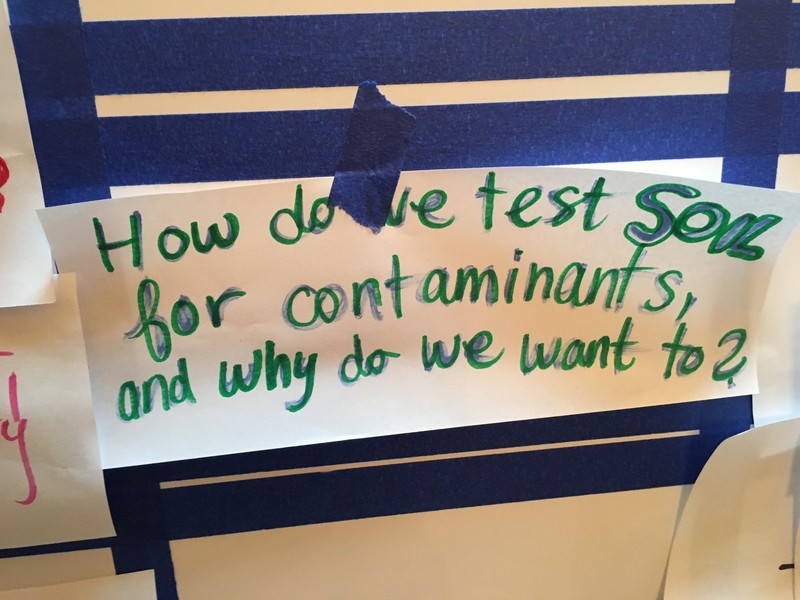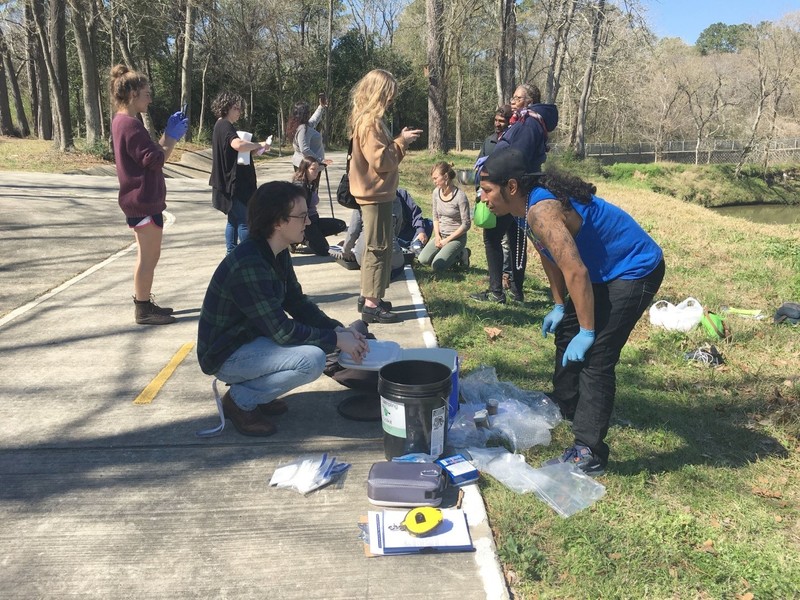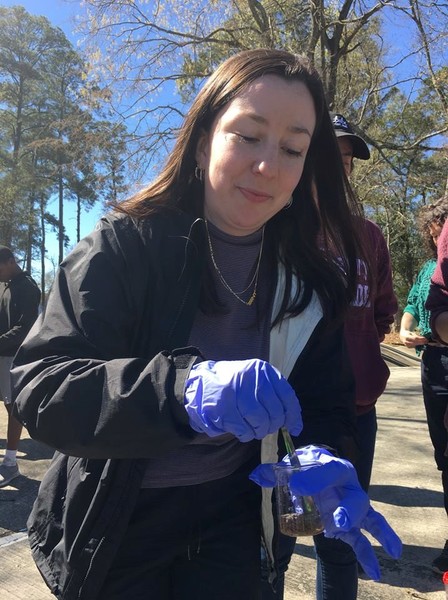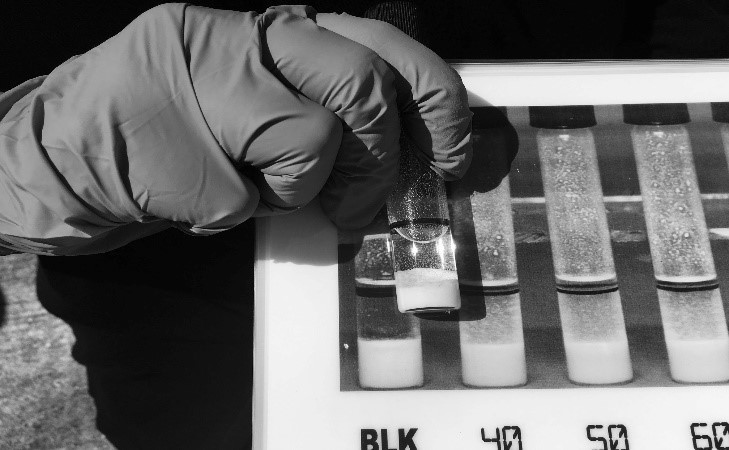Where were we?
Sunday at the Barnraising we went to Tidwell Park in Houston. The park is right by the community center and has active baseball and soccer fields, basketball courts, a playground, and a nature trail that runs alongside Halls Bayou. We spent some time balloon mapping, then a group went to do some soil testing along the banks of the bayou.

The community around
the park is concerned about contaminants in the soil, because the bayou
at the back of the park flooded during Hurricane Harvey, and backs up regularly.
Hurricane
Harvey re-distribute(d) contaminants from nearby oil and gas industry sites,
Superfund sites, and wastewater treatment plants throughout Houston and left
contaminants- such as heavy metals and polycyclic aromatic hydrocarbons (PAH's)-
behind on the soil as it drained. These contaminants are absorbed by the soil
and can stay on the top of the soil where people can be exposed to them, or
move through the soil profile to the groundwater. This poses a public health
issue, as exposure to these contaminants- especially for children- can have
negative health effects. One study done with soil samples pre and post Harvey
in Manchester neighborhood, Houston, found that PAH's were widespread throughout
the neighborhood, and that they were moved around during Harvey. Read more at: https://phys.org/news/2018-02-texas-pollution-hurricane-harvey.html#jCp

**What did we test for? **
We tested the soil for heavy metals, PAH's, and PCB's given the community's concerns, the site history, and the risk of exposure for children playing at the park and people living nearby and/or fishing in the bayou. This type of soil testing can contribute to 'baseline data' in environmental justice neighborhoods and help the understanding of what contaminants have been left behind in the soil and water as a result of the industry in Houston and the flooding events associated with the hurricane so that people have information to reduce exposure to these contaminants of concern and be informed about the impacts of industry in their area.
 *Gathered around the soil testing kits- the Hanby Field Kit for testing for Petroleum Hydrocarbons and soil sampling kit from Citizen Science Community Resources.
*Gathered around the soil testing kits- the Hanby Field Kit for testing for Petroleum Hydrocarbons and soil sampling kit from Citizen Science Community Resources.
Heavy metals (like Arsenic, Barium, Lead, Cadmium, Zinc and Mercury) do not break down, and can move around in floods and build up in soils. They are toxic at certain concentrations, and Arsenic and Mercury are particularly concerning in this context because they can be transformed in water and through the activity of microorganisms into more toxic and bioavailable forms.
Polycyclic aromatic hydrocarbons (PAH's) are known to be carcinogenic (cancer causing) and are associated with the burning of fossil fuels, so are likely in this context given the proximity to oil and gas industry and previous studies confirming their presence.
Polychlorinated biphenols (PCBs) are another contaminant of concern, because exposure to them can lead to neurobehavioral and immunological changes in children; and they are known to cause cancer in animals. They are known to build up in fats, especially in fish and seafood, and because we know that people fish in the bayou, we wanted to test for these too.
You can read more about soil contaminants here: Soil Contamination
How did we do it?
We took soil samples from the top 1-3 inches of soil at
various locations along the bayou. We took them from the top layer of the soil
because that is where we would expect contaminants to settle after flooding,
and also where people are most likely to be exposed to these contaminants. We
used Citizen Science Community Resources awesome "Soil Sampling Kit" to take
the samples **_(pictured below: ******____**__********"mso-bidi-font-weight:normal">"mso-bidi-font-weight:normal">="mso-bidi-font-style:normal">Evan
James is in Galveston TX at #txbarnraising
with Public
Lab showing off Citizen Science Community Resources DIY soil sampling
toolkit to help communities impacted by #climatechange).
_**
 _
_
_
People taking samples wore gloves (to stay safe and limit exposure to possible contaminants) and used a trowel that we cleaned with isopropyl alcohol to take samples. We took 6 samples to send to Test America, a professional lab, for analysis for heavy metals, PAH's, and PCB's. The lab provides sample collection containers, labels, and a cooler to keep the samples in until they are delivered to the lab. Soil samples being tested for heavy metals do not need to be kept on ice or refridgerated because quantity does not change, but any 'organic contaminant' such as PAHs and PCB's do need to be kept in dark, sealed, glass containers and kept cool until analysis by a lab because they can change in different temperatures and with exposure to air, thus altering (reducing, typically) the accuracy of your test results.


We also practiced some of the soil analysis methods we
learned earlier in the Barnraising, in a session on soil testing. We used the
Hanby Field Kit for Petroleum Hydrocarbons to test for PAH's, PCB's and a range
of petroleum products. You can read more about the process and methods for
using the Hanby kit here.

Kits like the Hanby use a process where you get the soil contaminants into solution by shaking them up with a solvent. Then you add a reagent, a chemical which reacts with the contaminant and produces a certain reaction, a color change. You then compare the color in the tube with a chart with the known colors produced by certain contaminants.

This method is more affordable than testing through a professional lab- the kit costs $1295 to purchase, and comes with 15 tests. Each test after that costs $15/test, as compared to $90-300 per sample through a lab. It is fairly simple to use and is an EPA-approved method, meaning it provides results that would hold up in court and be considered good science. ****
This project was made possible with support from the National Geographic Society.

2 Comments
The Hanby test kit and others (yes, there are other portable units) should only be used for screening purposes, per EPA. Nothing can be comparable to results from a certified lab. Hanby method also has some other limitations: per epa document https://clu-in.org/characterization/technologies/color.cfm "The limitations of the Hanby Field Test Kit may include inaccurate comparison of color if the sample is dark in color. Further, concentrations may be underestimated for highly refined petroleum fuels (those that are lacking in aromatic compounds). Interpretation of results may be inaccurate because of interference from other petroleum fractions."
Reply to this comment...
Log in to comment
The soil sample should be handle carefully to obtain the correct result from it. And in certain building Underpinning[https://cementconcrete.org/buildings/underpinning-methods-procedure-foundation-strengthening-repair/2092/] is done besed on the data of the soil sample from the foundation soil.
Reply to this comment...
Log in to comment
Login to comment.